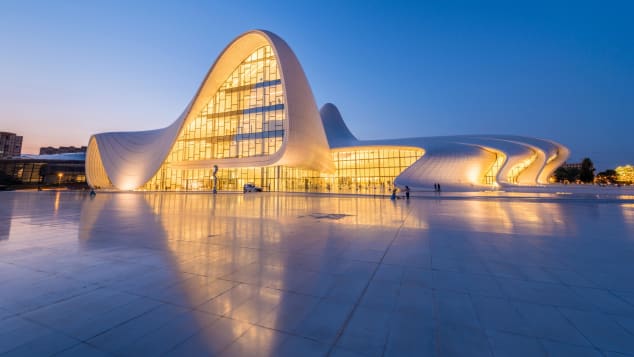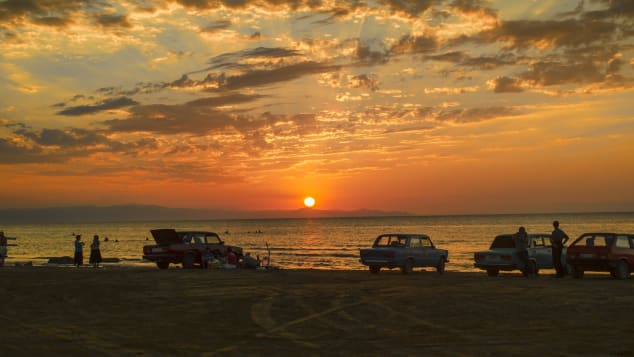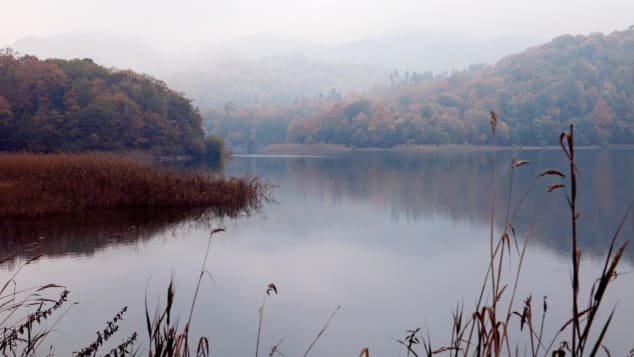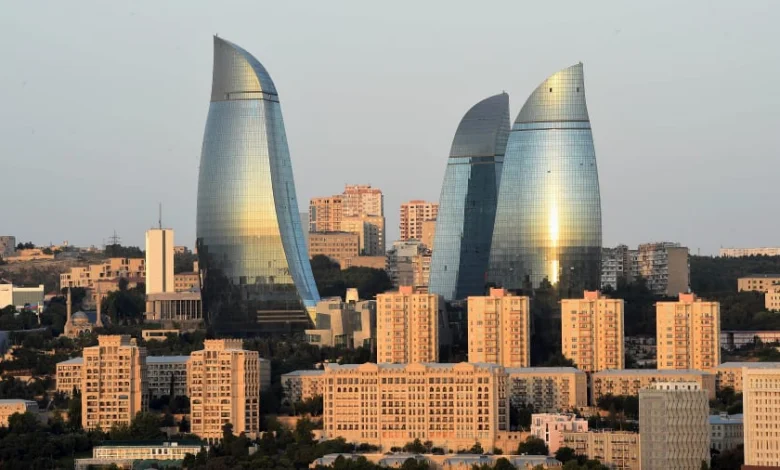Azerbaijan is the land of mountains and mud volcanoes, multiculturalism and mugham music.
Straddling East and West, it blends dramatic landscapes with a people and culture that reflect its fascinating location at the crossroads of Turkey, Russia and Iran.
For the past few years, neighboring Georgia has been the South Caucasian country to visit, meaning Azerbaijan has remained largely off the travel radar. But with a new and easy three-day visa service, reasonable prices and unbeatable hospitality, travelers that make it to the “Land of Fire” are often very pleasantly surprised.
Stroll through time in Baku’s Old City
Before the explosive development of the oil industry turned Baku into an industrial powerhouse of the Russian Empire, the city limits didn’t stretch much further than today’s Old City, which is still Baku’s cultural heart.
Inside are maze-like cobbled streets, artist’s workshops, cafés and museums.
Taking a guided walking tour around The Maiden’s Tower, Shirvanshahs’ Palace, old mosques and hammams is a great first step, but don’t miss trying Azerbaijani cuisine at one of the many authentic restaurants.
Visit Baku’s Museums

Azerbaijan is steeped in history and culture and while Baku may not be regarded as one of the world’s greatest museum cities, there are still several places well worth a visit.
The curvy, futuristic forms of the Heydar Aliyev Center (1 Heydar Aliyev Avenue), designed by the late Zaha Hadid, make this extraordinary structure an exhibit in itself but inside the center also regularly hosts world-class exhibitions.
Equally eye-catching is the Azerbaijan Carpet Museum (28 Mikayil Useynov Avenue; +994 12 497 2057) on the Baku Boulevard which contains in the region of 6,000 carpets representing all the seven schools of Azerbaijani carpet weaving.
Carpets here aren’t just visually appealing but also embody the beliefs and traditions of those that weaved them.
To explore the country’s fascinating past, it’s worth spending a few hours getting to grips with key events such as the oil boom, communism and the Karabakh Conflict at the National Museum of History of Azerbaijan (4 Haji Zeynalabdin Taghiyev Street; +994 12 493 3648), located in the former mansion of early 20th-century oil magnate Zeynalabdin Taghiyev, who is something of a local legend.
Take a day trip to Gobustan
They depict scenes of hunting, dancing, transport and animal symbolism, the oldest of them dating back more than 15,000 years, although there’s also an inscription left by the Roman Thunderbolt Twelfth Legion in the 1st century CE.
For those struggling to interpret them, the contemporary on-site museum offers plenty of context and guidance.
Also in the park and a short drive away is the best place to see some of Azerbaijan’s estimated 350 mud volcanoes (between 30% and 50% of the world’s total according to different sources).
Mud volcanoes do occasionally and unpredictably erupt so most of them lie in protected areas, but in Gobustan you’re free to clamber up the sides and watch their bizarre gurgling.
Tip: Trips to Gobustan’s petroglyphs and mud volcanoes can be organized from many if not most of Baku’s growing number of hostels, hotels and travel agents.
Explore the beaches of the Absheron

Summer in Baku is hot, so come late May the Baku residents who can will make a hasty escape to dachas (country houses) on the Absheron Peninsula, the area that protrudes into the Caspian like an eagle’s beak.
Similarly, travelers can find relief from the heat by jumping in a taxi, bus or hire car and heading for one of the Absheron’s beaches.
Baku beach culture is a unique phenomenon: Picture old Soviet cars parked right up against the water’s edge, picnicking families, samovars and watermelon.
On some beaches you will see local boys cantering along selling horse rides while on others you might catch macho young men jumping from abandoned oil equipment into the sea.
Sample honey and wine in Ismayilli
The village of Ivanovka is a legacy of the Caucasus’ once-thriving population of spiritual Christians that were banished from central parts of Russia in tsarist times.
Since the fall of the USSR many have returned north but Ivanovka is unique for still being a center of Russian culture.
Here you will find timeless streets lined with izba-style houses, some of the best honey in the Caucasus and Azerbaijan’s last functioning collective farm whose grapes are used to make the popular “Ivanovka” brand of wine.
Sheki, at the foot of the Caucasus Mountains in northwest Azerbaijan, is a former Silk Road city, which remains Azerbaijan’s center of silk and handicrafts.
Walking up Mirza Fatali Akhundov Street is a great way to explore local crafts such as making traditional papaq hats, halva, a super sweet form of pakhlava, traditional tekelduz embroidery and shebeke, which are intricate wooden latices fitted with stained glass, pieced together without glue or nails.
You can see how it’s done at the shebeke workshop in the Fortress of Sheki Khans a short walk from the top of Ahundov Street, and then witness the magical play of multi-colored light cast from the shebeke windows illuminating the interior of the exquisite, late 18th-century summer palace.
Hiking between Guba’s remote villages
Azerbaijan is blessed with some breathtaking scenery and few places can beat the Caucasus Mountains in the Guba region.
This area is also home to a multitude of ethnic minorities that speak their own languages and live in remote mountain villages. Two of those villages in particular — Khinalig and Griz — are becoming popular eco-tourism spots.
Until recently both of them could only be reached by traveling by foot or horse through rugged mountain passes, but a new road opened in 2011 which made it dramatically easier to get there and created a number of new hiking and ecotourism opportunities.
Even so, the journey is still a big part of the overall adventure as the only vehicles capable of negotiating the scenic but hazardous mountain routes are sturdy old Soviet jeeps. What lies at the top are breathtaking views and a way of life that will send you hurtling back in time.
Experience the Formula 1
Formula 1 is still something of a novelty in Baku as the first race only took place here in 2016. Like Monaco and Singapore, the Azerbaijan Grand Prix is a street race and the Baku City Circuit is the fastest of them all.
It was designed by German engineer Hermann Tilke to encompass most of the city’s major landmarks, so it winds along the old fortress walls, up historic Istiglaliyyat Street and onto the finishing straight which runs parallel to the Seaside Boulevard.
The inaugural race in the summer of 2016 was fairly uneventful but last year’s event saw plenty of crashes, controversy and an exciting finish. Since then the race has been brought forward to April which is a great time to visit Baku before the summer heat begins to kick in.
Weekend away in Nakhchivan
The legend goes that the iconic fang-like peak of Nakhchivan’s Mount Ilan Dagh (Snake Mountain) was carved out by Noah’s Ark as it retreated from Mount Ararat after the flood.
Biblical is perhaps the best way to describe the otherwordly landscapes of this Azerbaijani exclave wedged between Turkey, Armenia and Iran.
Getting there requires flying from Baku and the whole experience is both fascinating and atypical. Atypical because taxi drivers wear a special uniform, streets are spotless and undercover security guards will quiz you (politely) at the airport.
The Fascination lies in the ancient monuments, delicious lemons and breathtaking views across the River Araz to northern Iran.
Marvel at Lake Goygol

The most iconic site in the west of the country is the spectacular Lake Goygol (“Blue Lake”) at the foot of Mount Kapaz in the Goygol National Park.
The lake is actually one of a series, all of which formed after a massive earthquake in 1139 sent rocks hurtling into the Aksu River from the top of Mount Kapaz. Goygol is the centerpiece, around which there are a few hotels, teahouses and restaurants, but nearby Maral Gol, though smaller, feels more untarnished and remote, requiring a seven-kilometer hike or short minibus ride to get there.
The national park is about an hour’s drive from Azerbaijan’s second city of Ganja.
Much of it is untouched and therefore rich in wildlife, including wolves, jackals and bears. Along the way from Ganja you will encounter dramatic landscapes scattered with traditional teahouses and rural villages, plus the odd cow drifting obliviously across the road.
Tip: Given the high prices of the national park’s several hotels you’re better off staying in Ganja. The city’s rich history, youthful atmosphere and old redbrick buildings in the center mean it’s also well worth walking around.
Hit the slopes in Azerbaijan
Azerbaijan has two small but developing winter resorts that have opened within the last five or six years, offering an off-the-beaten-path skiing experience in the Caucasus Mountains.

